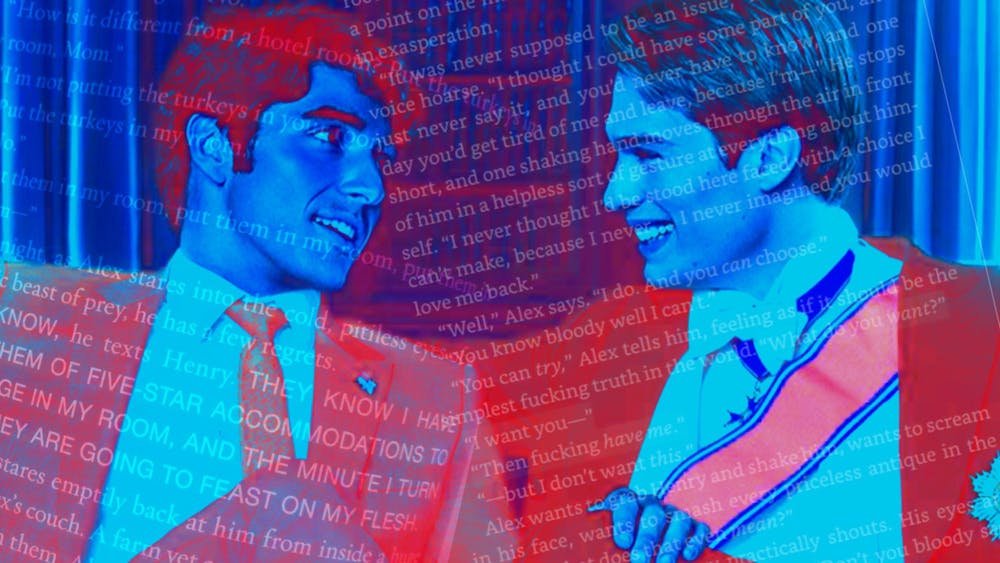Attending screenings of Red, White & Royal Blue in New York and Philadelphia, I had planned to sit back and enjoy a light–hearted “romance of the summer." But this was no average romantic comedy. In a genre often plagued by surface–level meaning and limited representation, Red, White & Royal Blue emerges as a swoon–worthy yet culturally significant film that authentically explores an intersectional spectrum of queer identities and experiences.
Amazon Studios’ adaptation of Casey McQuiston’s 2019 New York Times bestseller follows the relationship between Alex Claremont–Diaz (Taylor Zakhar Perez), a First Son of the United States, and Henry Fox (Nicholas Galitzine), the (fictional) Prince of Wales. Adhering to a traditional romantic comedy framework that will satisfy any fan of the genre, Red, White & Royal Blue is an enemies–to–friends–to–lovers story with comedic bits, profound hardships, tooth–rotting fluff, and existential questions about the possibilities of “happily ever after.” Yet amidst the romantic comedy cheesiness, it offers an impressively nuanced depiction of a same–sex couple navigating the tumultuous political world.
Alex and Henry depart from the stereotypical romantic comedy protagonists. Alex is the half–Mexican, bisexual son of America's first female president, played by Uma Thurman. He hails from a middle–class upbringing in Texas and catapults into the national spotlight through his mother’s presidency. His unapologetic intellect and charisma shine as he navigates public expectations, his intersectional identity, and personal desires. Henry, a prince of the British royal family, embodies a fascinating contrast: his privileged status as a member of England’s aristocracy seemingly contradicts fundamental elements of himself, like his (closeted) gay identity and longing to escape the limelight. The film follows Alex and Henry as they grapple with their identities individually and jointly while struggling with what their relationship could mean for their families, countries, and futures. In doing so, they avoid the peripheral plot lines and token representation often assigned to queer roles; they take center stage as intricately crafted characters highlighting various LGBTQ identities and experiences.
Red, White & Royal Blue also positions the backdrop of American politics and British royalty to interrogate various challenges faced by queer individuals and queer relationships. Alex and Henry address their sexualities privately, away from the harsh glare of public scrutiny. Alex confronts his bisexuality while trying to avoid the negative repercussions it could have on his mother’s intense reelection campaign, reflecting the unsettling reality that identity politics can be as divisive as conventional party ideologies. His journey also authentically acknowledges bisexuality, which is often overlooked in mainstream films. Henry conceals his gay identity amidst the sharp disparity between his family’s societal expectations for royals and his true self, obeying the rigid norms that threaten to consume him—akin to countless LGBTQ individuals who bury their identities as a means of self–preservation. Their parallel struggles across the Atlantic reflect some of the shared universal experiences of individuals grappling with their sexual orientation. Simultaneously, their hidden relationship emerges as a poignant symbol of the insufficient respect, privacy, and self–determination granted to famous and non–famous LGBTQ individuals alike.
The film further differentiates itself by heavily featuring Alex and Henry’s emotional, intellectual, and sexual chemistry. Depicting this multifaceted connection between a bisexual and gay man sheds light on their relationship with the same depth and complexity that is traditionally only granted to heterosexual ones in blockbuster films. Yet in doing so, it received an R–rating from the Motion Picture Association for “language, some sexual content and partial nudity.” This verdict shocked some of the film’s cast, crew, and early viewers like myself, who cannot rationalize how Red, White & Royal Blue is R–rated while other films of the same maturity are PG–13, like After. One could argue that this rating underscores the challenges LGBTQ content faces in achieving equal treatment in Hollywood.
Despite handling serious subject matters, Red, White & Royal Blue is a uniquely optimistic film. It sidesteps the tragedy and “bury your gays” cinematic tropes that reinforce harmful stereotypes and portray queerness as a sorrowful prison. Alex and Henry appear as star–crossed lovers who cannot help but fall in love, beautifully underscored by Perfume Genius’ cover of “Can't Help Falling In Love.” The film also includes a diverse cast of friends standing by their side who provide steadfast support for Alex and Henry’s love while honoring their privacy. They drive some of the film’s funniest moments, and showcase the power of allyship in confronting challenges. This support helps Alex and Henry overcome adversity and reach a well–deserved fairytale ending unique for LGBTQ audiences who “don’t actually get to participate in fairy tales themselves too often,” says director and co–writer Matthew Lopez in an interview with People. The film conveys a hopeful message to viewers that love is indomitable and knows no gendered, geographical, or figurative boundaries.
Red, White & Royal Blue arrives at a pivotal moment, countering the increasing anti–LGBTQ sentiment and legislation pervading throughout the United States. The novel’s banning across multiple American school districts since its release underscores the sobering impacts of such legislation, yet its messaging and optimism shine amidst this darkness. The film’s release also captures a unique blend of hindsight and foresight, as the novel was speculative fiction for the 2016 election. Red, White & Royal Blue offers a nostalgic reflection on recent history and what could have been while projecting a more inclusive future, inviting audiences to contemplate society’s strides and those it still has to achieve—quite a lot for a “light–hearted” romantic comedy.
In the words of the slightly cheesy subtitle of the book: History, huh? Bet this movie could make some.







